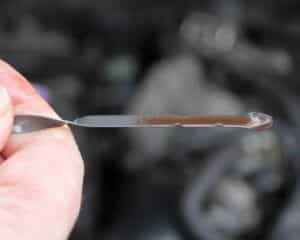
Does your vehicle have an automatic transmission? If so you are in luck because this blog post is all about checking the fluid level on automatic transmissions.
When a vehicle starts shifting funny as in like a hesitation, a hiccup between gear shifts and or maybe it doesn’t shift gears at all, it could mean your due for maintenance, having a mechanical issue or maybe your low on transmission fluid.
- Before you start to worry to much, take a deep breath, say woosah, and lets talk about how to check your transmission fluid level.
- Do you know how to check your transmission fluid level? If you are reading this will have to go with no. No worries, it’s typically an easy basic maintenance duty that could save you a trip to the local repair shop and a couple of bucks.
Locate Transmission Dipstick If Applicable
1st you’ll have to find the transmission dipstick if applicable. Hopefully you know how to pop the hood. If not I wouldn’t even suggest trying to check the fluid level and I’d call a friend and or a professional like the team of transmission experts over at Last Chance Auto Repair.
Once the hood is open the trans dip stick usually stands out as a yellow or red color but in some cases it’s black. In a lot of cases they will be labeled trans fluid, transmission fluid, transmission, ATF. But they are not always labeled and in some cases not accessible, not included and or they are locked (CVT transmissions). Where if that is the case you’ll want to bring your vehicle to a transmission shop to play it safe.
The location of the trans dipstick varies. Most rear-wheel drive (RWD) vehicles, put the dipstick towards the rear of the engine around the firewall. Front-wheel drive (FWD) vehicles, the dipstick is usually found sticking out of the transaxle. Some vehicles don’t have dipsticks. Some vehicles require the trans fluid level to be checked through a check hole/opening and some vehicles require a dipstick fluid level tool.
Checking Your Transmission Fluid
Now that you found your transmission’s dipstick (if vehicle is equipped with one), you can now check your transmission fluid level:
What you’ll need if your transmission fluid is low.
- A rag to wipe/clean off dipstick
- Transmission fluid needed
- A (transmission) funnel
Now, lets check the fluid level.
Make sure the vehicle is in park. Start the vehicle and let it warm it up to the normal operating temperature. It needs to be warmed up to get an accurate reading because trans fluid expands in heat. If you check the fluid when cold it will appear that it is low because the fluid hasn’t expanded. You do not want to overfill your transmission.
When your trans reaches the normal operating temperature and with the engine running you now pull out the trans dipstick. Before you wipe it off, I typically find a white sticker/label under the hood (a white piece of paper will work) and then wipe a sample of the fluid on to it to get an idea of the fluid condition. There are ways to test fluid for containements and lubrication viscosity but that will have to be saved for another blog post.
Hopefully the transmission fluid is a pink or red-ish color not a dark brown/black-ish color with sparkling metal debris floating around in it. Feasibly you want the fluid to smell like fresh transmission fluid not a burnt up/well done kind of cooked smell. These issues are signs that you need to change the transmission’s fluid & filter (if applicable) right away and or if there is metal shavings floating around it could be worse.
Finally lets wipe the transmission dipstick off and set it to the side. Different vehicles have different procedures for checking transmission fluid levels. Procedures are typically written on the transmission dip stick, it may be in the owners manual and or you can look it up online (and or in a book). But typically when the vehicle is warmed up you then needs to hold the brake pedal, shift it into drive (hold for 5 seconds), then shift it into reverse (hold for 5 seconds), repeat, park, re-insert, and then check the fluid level again.
You now should see transmission fluid on the dipstick. If it does not quite reach the “full” level, cross hatches, line that it is supposed to be at, use a funnel and pour some trans fluid (ATF) in (enough to reach the full level). DON’T overfill & ALWAYS make sure to use the proper transmission fluid. Repeat the fluid checking procedure, make sure it is where it needs to be and make sure to reinsert the dipstick when you’re done.
Check Our Plainfield Transmission Repair Shop on YouTube
Tips For Checking Your Transmission Fluid
If you are low and do need to add more transmission fluid, there are so many different kinds out there, you need to add the right fluid. To make sure your transmission lasts, doesn’t have any problems and for optimal performance, you will have to use the type specified by your vehicles manufacturer. Hence always use the proper fluid.
If you’ve noticed your trans is leaking, your vehicle shifting funny or if your not sure how to check your fluid level, your best bet is to bring it to a transmission shop near you. Having transmission problems Plainfield, Naperville, Bolingbrook, Romeoville, Illinois, near me, near you? Call Last Chance Auto Repair, schedule an appointment today, ensure that your transmission fluid is up to par and healthy before a little easy to resolve issue turns into a bigger, serious, more expensive to fix problem.



